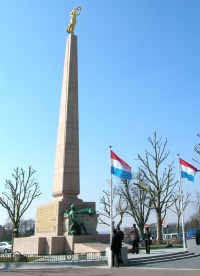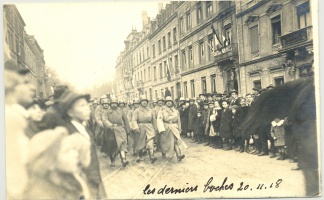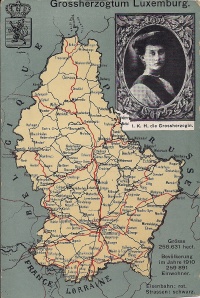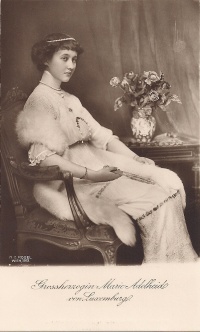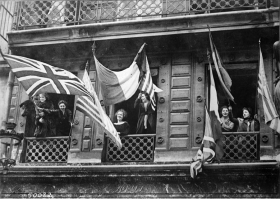Introduction↑
The First World War is scarcely present in the collective memory of Luxembourgers, and so far the country's historiography has taken little interest in this period. For a long time, scholarship focused on the attitudes of the monarchy and government between 1914 and 1918. The social turn of international historiography on World War I from the 1960s and 1970s only marginally touched Luxembourg.[1] The commemoration of the centenary did, however, bring the four years of occupation to the forefront of public interest and historiography in Luxembourg, although in general, World War I scholarship remains largely overshadowed by World War II scholarship[2]
| Masters' theses | PhD theses | |
| World War I | |
|
| World War II | |
|
Table 1: Master's and PhD theses dedicated to World War I and World War II in Luxembourg.[3]
Once Luxembourg joined the Zollverein, a German customs union, in 1842, the economic life of the Grand Duchy and the neighbouring German territories became strongly interlaced. In 1872, the Luxembourgish railway came into German hands. The boom of the iron industry was made possible by both German capital (for example Gelsenkirchen Bergwerk AG) and the German workforce (which made up more than half of the foreigners living in Luxembourg in 1910). On the eve of the Great War, the Grand Duchy was already within the the German Empire's economic range.
A Difficult Neutrality↑
Luxembourg was occupied on the morning of 2 August 1914, as it was essential for the German army to secure this important railway traffic node before the actual start of the war so that it could be used as a deployment area. The government protested against this violation of neutrality, which was guaranteed by the second Treaty of London (1867). On 4 August, Chancellor Theobald von Bethmann Hollweg (1856-1921) stated that Germany was compelled to “disregard the legitimate protest of Luxembourg and the Belgian government” [4], in order to avert a French invasion.
Led by State Minister Paul Eyschen (1841-1915), who had run the country since 1888, the political and economic elites continued to direct the country, allowing them to reason that at least in this regard Luxembourg continued to be neutral and sovereign. However, Luxembourg’s much-touted national unity was very fragile. Pre-war tensions between the majority block, consisting of liberals and socialists, and the right, quickly re-emerged. The grand duchess became, at least subliminally, a focal point of the conflict. Marie Adelheid, Grand-Duchess of Luxembourg (1894-1924), who ruled between 1912 and 1919, had already drawn criticism in the pre-war period for having spoken out against a liberal law. She in part maintained this policy during the war, which led to new elections in 1915. Furthermore, a pro-German attitude was attributed to her. Her entourage consisted mostly of Germans and she maintained close connections to the occupying power, as demonstrated by her reception of the German emperor in August 1914. The 26 August 1918 marriage announcement of Antonia, Princess of Luxembourg (1899–1954) with Rupprecht, Crown Prince of Bavaria (1869-1955) was also seen as unwise by many political observers in the country.
German Occupation↑
Unlike the World War II experience, the German occupation of Luxembourg during World War I did not include a German takeover of the administration. The German authorities did not interfere directly in the internal affairs of the country, nor did they interfere with the functioning of institutions or the use of languages: French retained its traditional preeminence. The constitutional and administrative organisations of Luxembourg remained intact. The German presence remained fairly light, and included about 5,000 German soldiers who were stationed permanently in Luxembourg. During the first weeks of the war, successive German armies passing through the country negotiated with the political and economic elite of Luxembourg. The lack of permanent contact persons posed repeated problems for the Luxembourgish authorities. Only five months after the invasion, in January 1915, a more stable structure (Militärverwaltung) was implemented under the direction of Richard Karl von Tessmar (1853-1928), which remained intact until the withdrawal of German troops in 1918.[5]
Politics↑
Between the start and the end of the war, there were five governments in Luxembourg: the Eyschen cabinet up until October 1915, the Hubert Loutsch (1878-1946) cabinet between November 1915 and February 1916, the Victor Thorn (1844-1930) cabinet between February 1916 and April 1917, the Léon Kauffman (1869-1952) cabinet between June 1917 and September 1918, and the Émile Reuter (1874-1973) cabinet from September 1918 until the end of the war. The Luxembourgish government was confronted with two major difficulties. On the one hand, it was necessary to quickly secure supplies for the population. On the other hand, the government was trying to maintain the independence of the country. The slowdown of the economy caused by the outbreak of war primarily affected foreign workers, who were the first to be laid off. Attempts to ensure supplies for Luxembourg through the Commission for Relief in Belgium failed due to Britain's opposition on the grounds that this should be Germany’s responsibility. However, the empire refused to allow the Grand Duchy its own supply policy. On 3 November 1916, the Grand Duchy was forced to declare itself ready to “entrust the German purchasing organisations” [6] with acquiring goods in neutral countries. From that moment on, it was no longer possible to sustain the illusion that Luxembourg’s political elite remained autonomous.
Economy↑
More generally, Luxembourg’s economy was integrated into the German war economy. The iron and steel industries indirectly supported the German war effort. Arbed, one of the major Luxembourgish companies, tried to maintain good relations with France and Germany simultaneously by maintaining networks in Paris and the Ruhrgebiet.[7]
Food scarcity↑
Of all the direct and indirect consequences of the war, it was probably hunger that hit Luxembourg the hardest. If people did not directly die of hunger, weakened bodies caused an increase in diseases such as tuberculosis and influenza. As in other countries, generational groups were affected differently by the rise in mortality. The elderly suffered the most as a direct consequence of supply problems; no longer enrolled in (in)formal solidarity networks around work, seniors experienced marginalisation that led to a significant surge in mortality.
| Year | 1912 | 1913 | 1914 | 1915 | 1916 | 1917 | 1918 | 1919 | 1920 |
| Mortality – 60-70 | 361.5 | 368.9 | 366.6 | 351.5 | 374.0 | 432.8 | 453.9 | 351.4 | 322.2 |
| Mortality – 70-80 | 671.3 | 650.8 | 671.8 | 670.1 | 724.3 | 750.0 | 753.0 | 705.6 | 598.3 |
Table 2: Mortality of the elderly[8]
Supply problems also rekindled the class struggle: to summarize, conservatives defended farmers, while liberals defended the steel industry and the interests of the bourgeoisie and socialist workers. The inability to resolve the supply crisis caused great frustration among the population. Economic and social liberalism, which had been the dominant ideology in Luxembourg in the 19th century, was suddenly called into question. The Luxembourg state, which previously had very little involvement in the market, positioned itself as a price regulator. On 15 March 1915, the government received “the necessary powers to order to safeguard the economic interests of the country during the war” (often referred to as “dictatorial powers”).
Rationing problems had a deep impact on the structure of Luxembourg society. Entire classes saw their living conditions decline during the war years. While traders saw business flourish during this period, with prices rising faster than they could offload their stock, the situation for employees, craftsmen and state employees was more concerning. Confronted with rising unemployment and lacking the means to store large amounts of food, the working class suffered most. However, the dividing lines were not only social, but also geographical, pitting the urban and industrialised south against the rural and agricultural north. Farmers were held responsible for the rise in food prices and significant tensions developed between them and the rest of the population.
In urban and industrial centers in the mining area, the dissatisfaction of consumers confronted with rising prices and supply difficulties was such that on 1 September 1916, the first Luxembourg union, the Luxemburger Berg- und Hüttenarbeiterband, was created and rapidly expanded throughout the mining region. The union was initially based in Esch/Alzette. Food shortages and employers' refusal to increase wages pushed the workers to strike in June 1917. The strikers demanded wage increases and better access to food. The strike was ultimately a failure for workers; no wage increases were obtained. The government, despite its “dictatorial powers”, refused to become involved in labour negotiations, claiming a desire to maintain a liberal non-interventionist stance. The occupiers were not concerned about keeping out of labour disputes; the German army could not tolerate disorder so close to the front. Colonel Tessmar put an end to the strike with a mixture of promises and threats. The union, still fragile and inexperienced, failed to assert itself against the employers, who refused to make any concessions.
Foreign Policy↑
With the country occupied, it was very difficult for Luxembourg to pursue its own foreign policy. Meanwhile, far-reaching plans for the post-war period were already being discussed in some of the belligerent countries. According to Bethmann Hollweg's Septemberprogramm, the Grand Duchy was to become a German province. Four years later, at the Spa Conference, these designs had only slightly changed. The Allied powers, many of whom criticized the conduct of the Luxembourgish court and government, had plans to put an end to the country's independence. Following Germany's defeat, however, the greatest threat to Luxembourg's sovereignty came from Belgium. The neighbouring country regarded the Grand Duchy as a lost heartland, to be reclaimed after the events of 1830-1839.[9]. Despite numerous diplomatic efforts during the war, the Belgian government failed to accomplish this goal after the war. This was partly due to Woodrow Wilson's (1856-1924) policy, which called for political self-determination, even for small nations.
In terms of foreign policy, the post-war period was a very uncertain time for the survival of the Grand Duchy. Domestic political tensions from the war years came into full play after the retreat of the German soldiers in November 1918. Simultaneously, the call for a Socialist Council on 10 November 1918 did not resonate with the population. On 21 November 1918, the first Allied troops, under the leadership of John J. Pershing (1860-1948), entered Luxembourg, followed by a double administration led by the American and French armies. These interventions did not drastically disrupt the country's political life. An attempt to proclaim Luxembourg a republic in January 1919 failed primarily because of the presence of French troops. The Grand Duchess Marie Adelheid could no longer maintain herself for political reasons and her sister Charlotte was appointed as her successor. In a 1919 referendum, approximately 80 percent of the voters were in favour of maintaining the monarchy under the new regent. The country withdrew from the Zollverein and joined a customs union with Belgium in 1921.
Collective Memory↑
Emigrants who fought as soldiers in Allied armies played an important role in the Luxembourgish memory-building process after the war. The majority of these volunteers had joined the French Foreign Legion, while others fought alongside the Belgian and American armies. In both France and the UK, Luxembourgers suspected of German-friendliness were arrested. The exact number of volunteers in the Allied armies is still unknown, but the number is likely less than the oft-quoted figure of 3,000 men. From a sample of more than 1,000 soldiers, the historian Joé Bellion calculated a loss rate of roughly one third, a high percentage compared to other countries, but still well below the 90 percent often quoted.[10] The commitment of expatriate Luxembourgers to the Allied powers allowed the country to see itself as on the side of the victorious Allies at the end of the war. On 16 March 1919, the population gave these soldiers an enthusiastic welcome in the capital. Four years later, a monument (Gëlle Fra) was built to commemorate the fallen soldiers.[11] In the interwar period, this monument served as a memorial, where flowers were placed during official state visits. The Nazis' removal of the sculpture in October 1940 led to demonstrations against the occupiers in the capital. The well-researched history of the Gëlle Fra overshadows the general weakness of collective memory in Luxembourg. Only a few monuments were built during the interwar period (primarily to commemorate civilians who died in bombings), and 11 November never gained the same significance in the Grand Duchy as it did in France or Belgium.
Conclusion↑
The war exacerbated social and political tensions that had been present during the second half of the 19th century in Luxembourgish society. In particular, the conflict around the figure of Marie Adelheid and tensions related to food scarcity exacerbated the cleavage between between the political right and the political left, and between urban and rural regions. This absence of national unity explains, in part, why these four years were not memorialised in the collective memory of the nation.
Benoît Majerus, University of Luxembourg
Charel Roemer, Université libre de Bruxelles
Section Editor: Marc Frey
Notes
- ↑ Trausch, Gilbert: Contributions à l’histoire sociale de la question du Luxembourg. 1914-1922, in: Hémecht 1 (1974), p. 5118.
- ↑ Several exhibitions were dedicated to World War I and, for the first time, collective works on the subject of Luxembourg during the First World War were published in 2014, for example: Majerus, Benoît / Roemer, Charles / Thommes, Gianna (eds.): 1914-1918. Guerre(s) au Luxembourg, Luxembourg 2014; Lieb, Daniela / Marson, Pierre / Weber, Josiane (eds.): Luxemburg und der erste Weltkrieg. Literaturgeschichte(n), Mersch 2014.
- ↑ Majerus, Benoît: Les historiens luxembourgeois monomaniaques. Histoires de la Première Guerre mondiale au Luxembourg, in: Majerus / Roemer / Thommes (eds), 1914-1918, 2014, p. 915.
- ↑ Trausch, Gilbert: La stratégie du faible. Le Luxembourg pendant la Première Guerre mondiale (1914-1919), in: Frank, Robert (ed.): Le rôle de la place des petits pays en Europe au XXe siècle, Baden-Baden 2005, pp. 47‑176, p. 55.
- ↑ Mettgenberg, Wolfgang: Luxemburg. Juristisch-politische Kriegserinnerungen, in: Zeitschrift für Völkerrecht XI/1 (1918), p. 2044.
- ↑ Trausch, Contributions à l’histoire sociale de la question du Luxembourg, pp. 5‑118, p. 30.
- ↑ Arboit, Gérald: Petits arrangements entre ennemis ou comment l’Arbed utilisa la Première Guerre mondiale pour devenir le premier groupe sidérurgique européen, in: Entreprises et histoire 68/3 (2012), p. 6678.
- ↑ Trausch, Gilbert: La mortalité au Luxembourg. 1901-1995, in: Cahiers économiques 88 (1997).
- ↑ During the Belgian Revolution, parts of the ancient Duchy of Luxembourg were integrated into Belgium. Some parts became the future Grand Duchy of Luxembourg.
- ↑ Bellion, Joé: Luxemburger in der französischen Armee während des Esten Weltkriegs, in: Hémecht 65/3 (2013), p. 267298.
- ↑ Majerus, Benoît: D’Gëlle Fra, in Kmec, Sonja / Majerus, Benoît / Margue, Michel /Peporté, Pit (eds.): Lieux de mémoire au Luxembourg. Usages du passé et construction nationale, Luxembourg 2007, pp. 291-296.
Selected Bibliography
- Arboit, Gérald: Petits arrangements entre ennemis ou comment l’Arbed utilisa la Première Guerre mondiale pour devenir le premier groupe sidérurgique européen, in: Entreprises et histoire 68/3, 2012, pp. 66-78.
- Bange, E.: Der erste Weltkrieg, in: Kmec, Sonja / Péporté, Pit (eds.): Lieux de mémoire au Luxembourg II. Jeu d'échelles / Erinnerungsorte in Luxemburg II. Perspektivenwechsel, Luxembourg 2012: Éditions Saint-Paul, pp. 19-24.
- Bellion, Joé: Luxemburger in der französischen Armee während des Ersten Weltkriegs, in: Hémecht 65/3, 2013, pp. 267-298.
- Calmes, Christian: Le Luxembourg au centre de l'annexionnisme belge, 1914-1919, Luxembourg 1976: Éditions Saint-Paul.
- Collart, August: Sturm um Luxemburgs Thron, 1907-1920, Luxembourg 1959: Bourg-Bourger.
- Flohr, Johann-Peter: Kriegstagebuch eines Neutralen in Luxemburg-Stadt. Flüchtig niedergeschriebene Aufzeichnungen und Stimmungen, Luxembourg 1921: Journal d'Esch.
- Hoffmann, Serge: Les difficultés de ravitaillement du Grand-Duché de Luxembourg pendant la première guerre mondiale, in: Galerie. Revue culturelle et pédagogique 1, 1985, pp. 25-38.
- Lieb, Daniela / Marson, Pierre / Weber, Josiane (eds.): Luxemburg und der Erste Weltkrieg. Literaturgeschichte(n), Mersch 2014: Centre National de Littérature.
- Majerus, Benoît / Thommes, Gianna / Roemer, Charles (eds.): 1914-1918. Guerre(s) au Luxembourg / Krieg(e) in Luxemburg, Luxembourg 2014: Capybara Books.
- Morgan, Janet P.: The secrets of Rue St Roch. Intelligence operations behind enemy lines in the First World War, London 2004: Allen Lane.
- Robert, Jean-Pierre: Die Fliegerangriffe auf Luxemburg während der Weltkrieges 1914-1918 in historisch-chronologischer Darstellung, Luxembourg 1922: Th. Schroell.
- Trausch, Gilbert: La stratégie du faible. Le Luxembourg pendant la Première Guerre mondiale (1914-1919): Le rôle et la place des petits pays en Europe au XXe siecle (Small countries in Europe, their role and place in the XXth century), Baden-Baden; Brussels 2005: Nomos; Bruylant, pp. 45-176.
- Trausch, Gilbert: Les deux occupations allemandes (1914-1918 et 1940-1944) en comparaison. mémoire collective et précédent: ... et wor alles net esou einfach. Questions sur le Luxembourg et la Deuxième Guerre mondiale. Contributions historiques accompagnant l'exposition = Fragen an die Geschichte Luxemburgs im Zweiten Weltkrieg. Ein Lesebuch zur Ausstellung, Luxembourg 2002: Musée d'histoire de la ville de Luxemburg, pp. 346-359.
- Trausch, Gilbert: Contributions à l'histoire sociale de la question du Luxembourg 1914-1922, in: Hémecht 1, 1974, pp. 5-118.
- Welter, Nikolaus: Im Dienste. Erinnerungen aus verworrener Zeit, Luxembourg 1926: St. Paulus-Druckerei.





